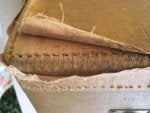I have a question for the experts, but first....In the end, nothing really matters except how one feels about a horn when they hold it and play it. I've all but given up on being able to date my Buescher Elkhart 30A tenor, but I know that I like it a lot. There is such a wide range of guesses on the web coming from owners of this horn model that it's crazy; Some people think that these were all made in the 1930's. Others think that they are/were produced late 1940's through early 50's. Some say they are all related to True Tone models.
Some say thin brass and others state that it sounds as good as or better than a True Tone, some people including myself have noticed that there are several different "Elkhart Built by Buescher" logos inscribed on the bell and some are taller than others, some have the Elk antlers within the heart but others have the antlers extending outside of the heart, The Elk face is different on some of these horns, etc, etc....
Rather than so many being confused about when their horn was made based off of serial numbers, I'm wondering if it's possible to date just about any horn (approximately and knowing that it's original to it's case) based on case construction and hardware?
For example, I know that this horn originally came with this case. The original spring loaded clasps on this lovely old case have hardware that is stamped " P Northfield NJ Made in USA" and I would think that the hardware changed pretty frequently, or at least once every decade.
Finally, I would just like to say that I've played/play Martin, Conn and Buescher and I love the sound of my Buescher Elkhart 30A. Its sound is very, very big and it's rich.
Dating by case construction/hardware or the color of velvet is just a thought that I had.....
Any idea what era/decade my horn was made in? Let the confusion begin!
Some say thin brass and others state that it sounds as good as or better than a True Tone, some people including myself have noticed that there are several different "Elkhart Built by Buescher" logos inscribed on the bell and some are taller than others, some have the Elk antlers within the heart but others have the antlers extending outside of the heart, The Elk face is different on some of these horns, etc, etc....
Rather than so many being confused about when their horn was made based off of serial numbers, I'm wondering if it's possible to date just about any horn (approximately and knowing that it's original to it's case) based on case construction and hardware?
For example, I know that this horn originally came with this case. The original spring loaded clasps on this lovely old case have hardware that is stamped " P Northfield NJ Made in USA" and I would think that the hardware changed pretty frequently, or at least once every decade.
Finally, I would just like to say that I've played/play Martin, Conn and Buescher and I love the sound of my Buescher Elkhart 30A. Its sound is very, very big and it's rich.
Dating by case construction/hardware or the color of velvet is just a thought that I had.....
Any idea what era/decade my horn was made in? Let the confusion begin!







